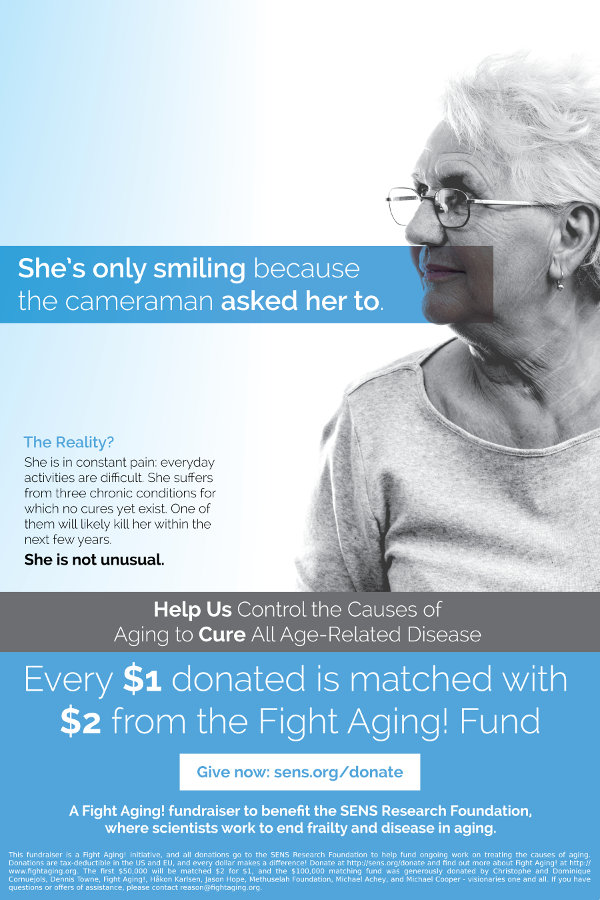Unfortunately, the SENS approach to aging is still the disruptive, growing newcomer in the research community. The vast majority of longevity research efforts focus on altering the operation of metabolism in order to slow the pace of damage accumulation in aging. This is a part of the field in which there is no clear technical path forward, however. More than a billion dollars have been spent over the past decade with little to show for it but incrementally greater knowledge, and even if results were obtained in the decades ahead, they would be of little use to old people. There isn't much you can do with a way to slow aging if you are already so old and damaged as to be close to death. In time this present state of affairs will change, and SENS will take over the mainstream by virtue of producing better results and at a far lower cost.
This process of disruptive bootstrapping requires greater public support and greater funding than presently exists, however, which is why our help and our donations are so important. A great deal has already been achieved over the past decade as a small community of supporters and scientists took SENS from initial idea to ongoing research program that enjoys the support of many noted figures in the scientific community. Success is always just a starting point for the work of tomorrow, and much more lies ahead if we are to achieve the goal of an end to disease and frailty in aging. The times are changing:
The present budget for the Foundation is modest for a research center or for an advocacy organization. At around $4 million for 2013 it is a tenth of the size of a major independent institution in the field such as the Buck Institute for Research on Aging. You might also compare it with the grants of a few million dollars apiece made by the Glenn Foundation for Medical Research over recent years to establish a network of aging research laboratories. In general aging research is the poor cousin in the broader field of medical research, and you'll see ten times these amounts floating around the cancer and stem cell research communities on a regular basis. That too is something that must change.
The Foundation funds research programs in more than a dozen labs at the present time, and you'll find notes on all of them in the later pages of the report. You should of course read the whole thing:
SENS Research Foundation supports a global research effort. Our own scientists are based in our Mountain View, California facility and we fund researchers at field-leading institutions around the world. As we age, we accumulate decades of unrepaired damage to the cellular and molecular structures of our bodies. The types of damage are few in number - we count seven, currently - but cause a great many diseases of aging, including cancer, Alzheimer's and atherosclerosis. Rejuvenation biotechnologies target this underlying damage, restoring the normal functioning of our bodies' cells and essential biomolecules. As preventative interventions they halt the harmful accumulation of damage, stopping disease before it ever starts.
Cell Therapy for the Intestinal Tract, Wake Forest Institute for Regenerative Medicine
At WFIRM, SENS Research Foundation is funding a project to restore intestinal structure and function. The central goal is the development of a regenerative medicine approach to treating inflammatory bowel disease (IBD), an autoimmune disorder that devastates the cells lining the intestine. Though IBD is not a disease of old age, therapies that repopulate the cells of the gut are critical to the development of a new generation of cancer therapies, as these therapies are likely to depopulate the stem cell reserves of several tissues (and replace the missing cells with fresh, cancer-protected stem cells).
Clearance of Macrophage Oxysterols Driving Atherosclerosis, Rice University
The SENS Research Foundation-funded team at Rice University is working to tackle two intracellular aggregates driving age-related disease and dysfunction: macrophage oxysterols (the core lesion underlying heart disease, via foam cell formation) and lipofuscin (a potential factor in multiple degenerative aging processes).
Chemistry Toward Cleavage of Advanced Glycation Crosslinks, University of Cambridge, Yale University
Advanced glycation end-products (AGEs) are a class of compounds that accumulate in our tissues as part of the degenerative aging process. The Yale AGE team is working on new tools for the detection of AGEs and their precursors. The program will synthesize glucosepane, currently thought to be the single largest contributor to tissue AGE crosslinking, and the understudied crosslink pentosinane. The team will then to use these compounds to develop new antibodies and reagents to enable rejuvenation research. Ongoing experiments in collaboration with SENS Research Foundation's Cambridge research center are focused on developing antibodies against CML (a common reactive glycation product) and MGH. These efforts will be expanded once glucosepane constructs are prepared.
Investigating the Nature of Academia-Industry Interaction in the Translation of Gene Therapies, University of Oxford, Centre for the Advancement of Sustainable Medical Innovation
The recent clinical success of gene therapy has increased the visibility of the field, attracting interest from industry. It faces commercialization challenges which differ from conventional therapeutics due to complex manufacturing procedures, record-breaking price tags, and the potential for truly personalized approaches. The first stage of the project analyzes the features of researchers and research at the University of Oxford which have led to support from industry. Surveys of industry partners aim to identify how these features are perceived, and why they influence the allocation of industry funds. This project also examines the mechanisms by which collaborations form in preclinical research. The second stage of the project considers the critical role of academia-industry collaboration in the translation of these novel high-risk, high-cost technologies. This collaboration is critical in bringing these therapies to patients.
Optimizing the Quality and Effectiveness of Risk, University of Oxford, Centre for the
Advancement of Sustainable Medical Innovations
There is declining productivity in biomedical research and development in terms of new product approvals, in part due to an inherently risk averse regulatory pathway for novel healthcare innovations. This is despite major achievements and opportunities in novel technological platforms. The portfolio of risk:benefit methodologies have been applied inconsistently and often conflated with cost-effective analysis. This yields results that do not effectively inform clinical practice or strategies for biomedical innovation. This investigation aims to assess risk:benefit appraisal methodologies in the analysis of published randomized controlled trials for pre-licensure biomedical.
Targeting the Senescence-Associated Secretory Phenotype, Buck Institute for Research on Aging
Senescent cells also develop resistance to signals for apoptosis (cellular suicide) and secrete inflammatory signaling molecules and protein-degrading enzymes into their local environment. This last phenomenon is called the senescence-associated secretory phenotype (SASP). SASP is thought to play a role in the chronic inflammation that is widespread in aging tissues, which in turn promotes the progression and propagation of age-related frailty and the many diseases of aging. With SENS Research Foundation funding, the Buck Institute SASP project has been screening small molecules for their effects on fibroblasts (a kind of skin cell) that have been rendered senescent by ionizing radiation, with the aim of identifying agents that could either selectively kill senescent cells, or interrupt the SASP and prevent its harmful effects.
Maximally-Modifiable Mouse, Applied StemCell, Inc.
The goal of the Maximally Modifiable Mouse (MMM) project is to generate mouse models allowing easy genetic modification at any time point during the mouse's lifespan, thus hastening the process of testing potential interventions against age-related disease. The MMM project aims to generate a new line of transgenic mice with "docking sites" for a high-precision targeting system for gene insertion that are not typically found in mammals engineered into their genomes. The docking site will then be ready for the insertion of new therapeutic transgenes at any time during the mice's lifespan, allowing for the testing of candidate therapies.
Rejuvenation of the Systemic Environment, University of California, Berkeley
The experimental technique of heterochronic parabiosis, in which the circulation of an aged animal is joined to that of a young one, exposes the aged organism's tissues to a youthful systemic environment (and vice-versa). The UC Berkeley systemic environment team is exploring the influence of the systemic environment on aging processes using a novel computer-controlled technological platform and specialized hardware made from off-the-shelf and custom 3-D printed parts. This platform enables the group to easily and safely extract blood from small animals, process what they extract in any of several ways, and either return it to the original animal or exchange it with that of an oppositely-aged animal. Plasma contains the soluble signaling molecules of interest in parabiosis experiments, and the use of plasma instead of whole blood enables scientists to disentangle the effects of an old animal having access to the young animal's blood cells and organs from the effects of the factors found circulating in the systemic environment.
Clearance of RPE Aggregates Driving Macular Degeneration, SENS Research Foundation Research Center
Our cells contain vesicles called lysosomes that use enzymes to recycle cellular wastes. Some stubborn wastes, however, are beyond the lysosome's evolved capacity to break down. These products accumulate in the cell's main body or in the lysosome, and may even make their way outside the cell. In the eye, extracellular garbage called drusen gradually accumulates in a portion of the retina called the macula. Drusen accumulation is an indicator for age-related macular degeneration (ARMD), the leading cause of blindness in persons over the age of 65. The SRF-RC RPE aggregate team is working to identify enzymes capable of degrading recalcitrant wastes and restoring lysosomal activity in RPE cells, which could enable ongoing maintenance of macular photoreceptors and prevent the appearance of drusen and the development of ARMD.
Tissue-Engineered Thymus, Wake Forest Institute for Regenerative Medicine
The thymus engineering group at WFIRM is working to produce new thymus tissue with a rejuvenated ability to produce T-cells, helping to restore the immune system's youthful strength. The scientists are using the powerful "decellularized scaffold" approach. Researchers begin with a donor organ and strip it of its original cells, leaving a "scaffold" of extracellular matrix (ECM) onto which cells derived from the transplant recipient can be seeded.
Allotopic Expression of Mitochondrially-Encoded Proteins, SENS Research Foundation Research Center
The accumulation of cells harboring deletion-mutation-containing mitochondria is a significant consequence of aging, and is implicated in age-related disease. The SRF-RC mitochondrial mutations team is working to develop engineered mitochondrial genes that could be stored safely in the cell's nucleus and function as "backup copies" for cells whose mitochondria harbor deletion mutations. They are currently working to realize the potential of a new method for targeting these engineered nuclear-encoded genes to the mitochondria, and to optimize the precision of this targeting.
Diagnostic and Therapeutic Antibodies against Transthyretin Amyloids, University of Texas-Houston Medical School, Harvard University
A key driver of age-associated ill health is a form of molecular damage in which certain proteins in the body lose their native structure and bind together with one another, forming harmful aggregates. One less-known amyloid disease is senile systemic amyloidosis (SSA), a disorder caused by aggregation of a hormone-transporter protein called transthyretin (TTR). With SENS Research Foundation support, the UTHMS TTR amyloid team is working to develop engineered catalytic antibodies ("catabodies") targeting misfolded TTR as a rejuvenation biotechnology for prevention and treatment of TTR amyloidosis. These "catabodies" combine the specificity of conventional antibodies with the catalytic power of enzymes, giving a single catabody molecule the ability to permanently degrade large amounts of target amyloid.
Identification of the Genetic Basis of ALT, SENS Research Foundation Research Center
To survive, all cancers must develop a mechanism to re-lengthen their telomeres. Many cancers do this by hijacking the genes involved in regulation of the enzyme telomerase, which are only supposed to be expressed by certain specific cell types under very tight control. 10-15% of cancers, meanwhile, employ a telomerase-independent mechanism known as alternative lengthening of telomeres (ALT). The SRF-RC ALT group has has developed a fast, high-throughput assay method and will use the new, faster ALT assays to hunt for genes that might be involved in the ALT machinery, and screen libraries of drugs to identify new candidate treatments that would shut down ALT cancer cells.
Epimutations: Targets or Bystanders for Rejuvenation Biotechnology? Albert Einstein College of Medicine
Just as our genes can suffer mutations that damage the instructions cells use to make their encoded proteins, so too our cells can suffer damage to the "epigenetic" structures that help to regulate whether a particular gene is turned on or off in a particular kind of cell at a particular time. These epimutations therefore cause cells to turn the expression of particular genes on or off aberrantly. The Albert Einstein College of Medicine (AECOM) epimutations team is investigating the possibility that epimutations could be contributing to age-related disease. Numerous cells in a tissue could, in this scenario, be engaging in aberrant gene expression, leading over time to tissue dysfunction and eventual pathology.



